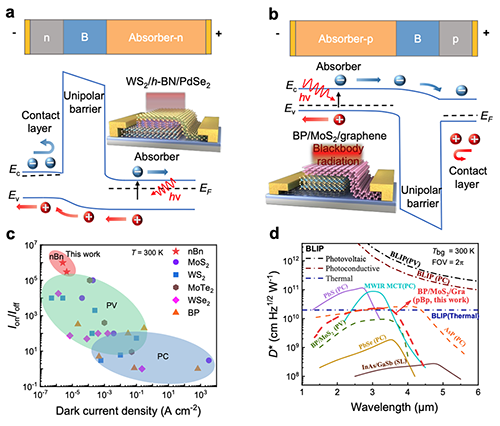| Jun 24, 2021 | |
Unipolar barrier photodetectors based on van der Waals heterostructures |
|
| (Nanowerk Spotlight) Photodetectors with blackbody response show significant applications in remote sensing and infrared imaging. However, up to now, few works have demonstrated excellent response to blackbody radiation (weak irregular radiation from a real object), which is essential to reliably evaluate their potential in practical detections. | |
| Among most key parameters, high dark current is a core bottleneck that restricts infrared photodetectors with high performance. Since Bell Labs produced the Si-based PN junction in 1935, utilizing the built-in electric field in the depletion region has become the main technical route to block dark current. | |
| In traditional PN junctional infrared photodetectors, the high Shockley-read-Hall (SRH) recombination and surface recombination in the depletion region seriously limit the suppression of dark current. Therefore, a new device structure beyond the PN junction, the unipolar barrier structure, has been proposed, which is used to suppress dark current in photodetectors by blocking majority carriers and enables infrared photodetectors to operate at high temperature. | |
| However, for conventional bulk materials, lattice mismatch and defects at the interfaces are inevitable in the process of epitaxial growth, which impedes the development of high-performance unipolar barrier photodetectors. | |
 |
|
| Figure 2. Band diagrams and performance of the unipolar vdW heterostructures. a, Band diagram and device structure of the nBn unipolar barrier photodetector. b, Band diagram and device structure of the pBp unipolar barrier photodetector. c, Comparison between dark current density and Ion/Ioff ratio. d, Blackbody detectivity comparison in the infrared. (Image courtesy of the researchers) (click on image to enlarge) | |
| In this article, we have demonstrated van der Waals (vdW) unipolar barrier photodetectors with nBn and pBp heterostructures. Designing unipolar barriers with conventional materials is challenging due to the strict requirements of lattice and band matching. | |
| Two-dimensional (2D) materials can be used to construct vdW unipolar barrier photodetectors without the lattice-mismatch and interface defects problems owing to naturally self-passivated surfaces which can avoid the generation of leakage current. Besides, 2D materials possess layer-tunable band structures that can be scientifically designed and stacked to construct nBn or pBp band alignments. | |
| By specially designing unipolar barrier structures, the dark current is effectively blocked, while the photocurrent is not suppressed. In the case of nBn, the conduction band barrier can effectively block the movement of electrons from the contact layer to the absorption layer, and make the surface current greatly attenuated. At the same time, the distribution of the depletion region is close to the wide-bandgap barrier layer which reduces the SRH current. | |
| In addition, with the decrease of the carrier concentration in the absorption layer, the Auger recombination which determines the hot noise can be effectively suppressed. Herein, the fabricated 2D vdW unipolar barrier photodetectors exhibit an ultralow dark current and an ultrahigh light Ion/Ioff ratio compared to that in photoconductive (PC) and photovoltaic (PV) photodetectors. | |
| The WS2/h-BN/PdSe2 nBn unipolar barrier photodetectors have an ultralow dark current of 15 pA, a remarkable photocurrent of 20 µA, and a detectivity of 2.7×1012 cm Hz1/2 W-1 at room temperature. Moreover, 2D pBp unipolar barrier photodetectors demonstrate an excellent room-temperature detectivity as high as 2.3×1010 cm Hz1/2 W-1 at 3.8 µm under blackbody radiation. Meanwhile, the devices realize a dichroic ratio of 4.9 under blackbody radiation and a response time of 23 µs under 2 µm laser illumination. | |
| The proposed novel vdW unipolar barrier heterostructures provide a solution to the bottleneck of dark current in infrared photodetectors and bring a key technological breakthrough to the ‘lab-to-fab’ transition of two-dimensional materials in the field of infrared application. | |
| This work has been published in the journal Nature Electronics ("Unipolar barrier photodetectors based on van der Waals heterostructures"). This work is supported by the National Natural Science Foundation of China, National Key Research and Development Programme of China, Research Project of Frontier Science of CAS, and Fund of Shanghai Natural Science Foundation. | |
| Source: Provided as a Nanowerk exclusive by Shanghai Institute of Technical Physics of the Chinese Academy of Sciences | |
|
Become a Spotlight guest author! Join our large and growing group of guest contributors. Have you just published a scientific paper or have other exciting developments to share with the nanotechnology community? Here is how to publish on nanowerk.com. |
|
